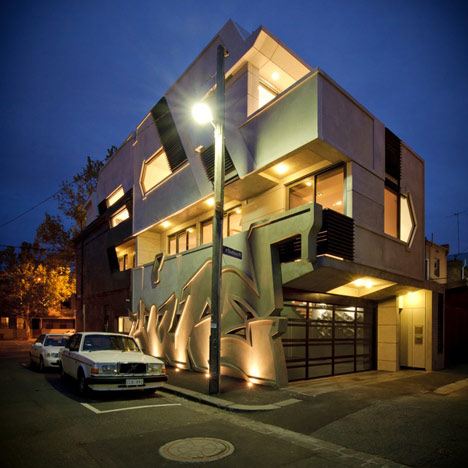
The Hive Apartment by ITN Architects
The facade of this Melbourne house for an architect and a street artist has built-in graffiti.
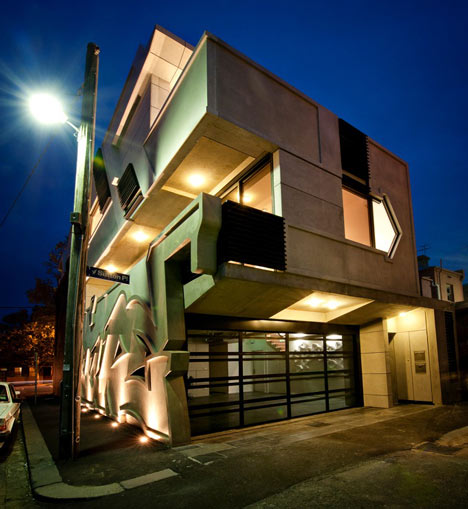
Zvi Belling of ITN Architects asked local graffiti artist Prowla to come up with the design, which spells out 'HIVE' in wild-style lettering.
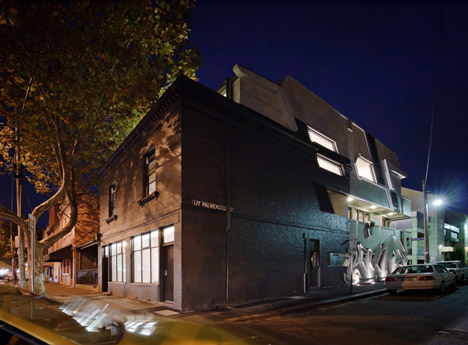
The precast, four-metre-high concrete letters are load-bearing and the facade has been fitted into the exposed brick shell of an old tailor's shop.
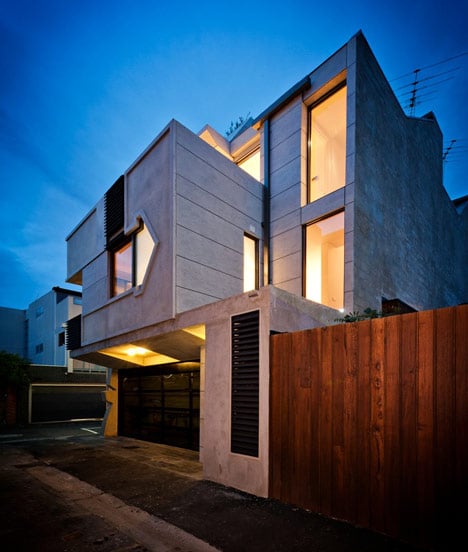
The angles of the letters determine some of the wall shapes and interior spaces. Gaps between letters create small windows which let light into unexpected places, while sliding panels conceal louvred ports for ventilating the rooms.
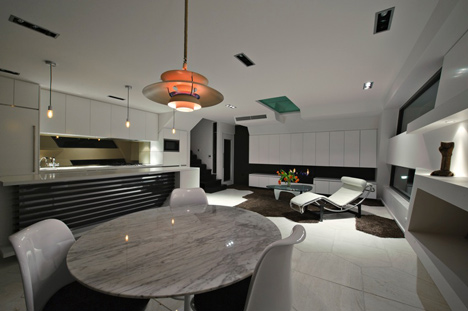
The interior is fitted out in a sci-fi style with sharp angles reflecting the arrows seen on the facade.
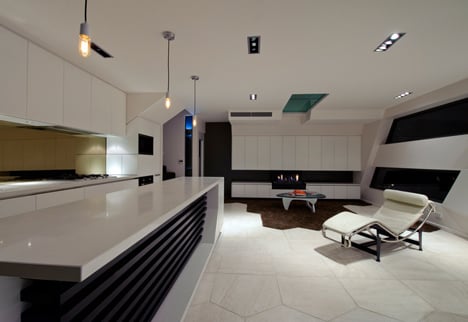
The apartment is the first in a series of "Hip Hop Buildings" designed by ITN Architects.
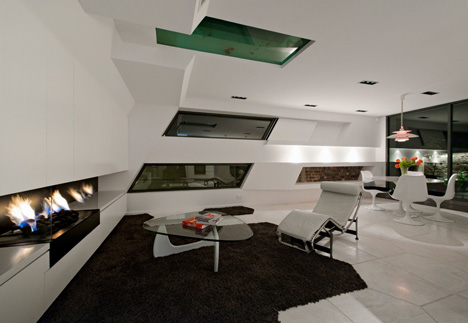
Photographs are by Patrick Rodriguez and Zvi Belling.
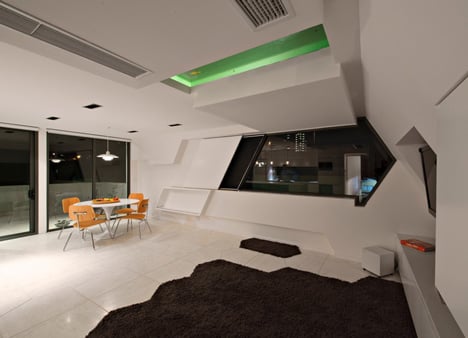
See more houses in Australia »
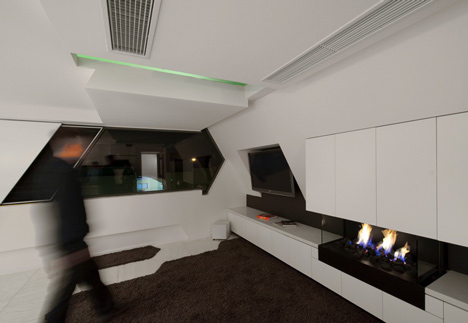
See our other stories from Melbourne »
Here's more information from the architects:
The Hive Apartment
Architect's statement
The Hive Apartment was designed by architect Zvi Belling of ITN Architects.This site was specifically selected for a graffiti/architecture project. The ideas in the building have been refined over time by the designer in prior competitions, publications and collaborations with street artists. The architect developed the project with his neighbour (aka Prowla), a respected old school Melbourne graffiti ‘writer’ who contributed the design of the graffiti letters.
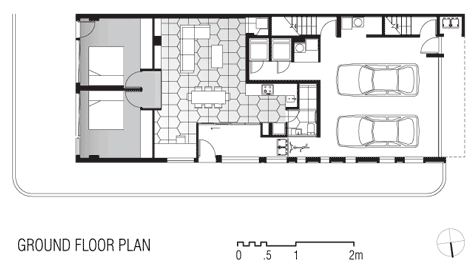
The external precast concrete walls of the apartments are inscribed with these letters and other hip hop iconography. The graffiti relief panel spells HIVE written in ‘wild style’ with some initiation into the cultural codification of letters being required to decipher the words. These external geometries directly determine the interiors and have been extruded into living spaces in bulkheads and wall shapes.
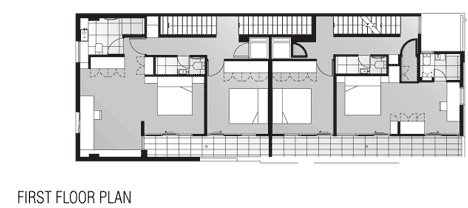
There are inherent tensions in the building where graffiti complete with spray drip effect has been created without any paint and an anti-establishment art form has been situated in an exclusive inner city residential suburb. These tensions are resolving over time as respect for the building spreads within the graffiti community and the local residents begin to claim ownership of their new street art. The outward presentation of robust public art fortifies the internal spaces into a calm refuge that is adorned with street art frames and canvasses. The notion of hive as home has been extracted from the facade and reappears through the fit-out in various guises.
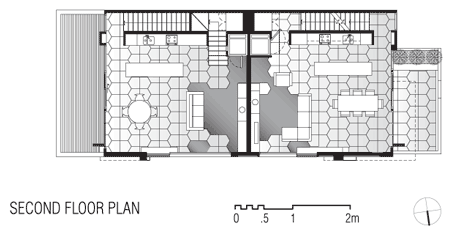
The concrete relief façade containing shapes such as letters, arrows, swooshes and drips has been slotted into the exposed brickwork shell of an old Carlton tailor shop. It was important for the street art, graffiti in this case, to be essential to the experience of the building inside and out. The 4m high concrete letters are load bearing with the weight of all four stories transferring to the footing through the oversized letter ‘E’ and simultaneously creating a dramatic visual entry to the apartment. Similarly the punctuations in the facades allow interesting views and natural light opportunities within the habitable spaces.
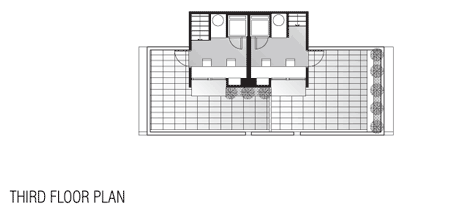
The graffiti letters were initially conceived of as a masonry element but through collaboration with Euro Precast, concrete was adopted for the façade and by extension as the structural system for the entire building. Logistical innovation was required to install the 4m high, 14 tonne load bearing 50mpa letter panels at the commencement of the construction program and protect these feature panels through the construction period. The architect and the graffiti artist were involved with the setup, concrete pour and delivery phases of the panel fabrication.
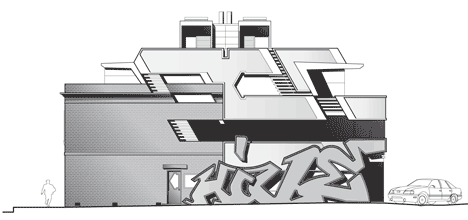
Click above for larger image
The project was completed within $50K of the initial estimates. Working closely with the builder, while maintaining flexibility was the key to ensuring savings through the life of the project.
The project is the architect’s home and as such was an opportunity to experiment. There are concealed sliding panels revealing louvred ports for cross ventilating habitable rooms. There are unusual door arrangements to minimize temperature exchange between zones. Solar panels are located on the roof and a water storage tank has been installed below the car park area. Reusing available building fabric and designing small footprint high density living are significant environmental features of the development.
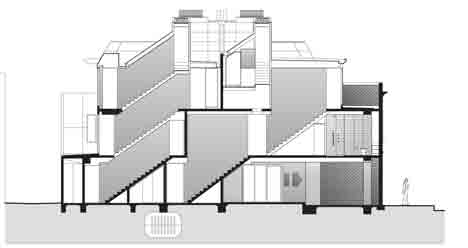
Click above for larger image
The new apartment is an intervention into the fabric of this Carlton block but through apparent contradiction seeks to knit itself into the existing building on the site to form an integrated new cultural type that exposes the history of the site with glimpses of period material and detail. An urban street is celebrated through the making permanent of an ephemeral art.
PROJECT TEAM
Architects: ITN Architects
Project Architect: Zvi Belling
Project Team: Silas Gibson; Jenny Cham; Atsushi Kubota
Graffiti Artist: Prowla - RDC Crew Melbourne
Builder: Kalitek Constructions
Engineer: Meyer Consulting Engineers
Building Surveyor: Building Strategies
Hex wall panel art: Enlai Hooi
Precast concrete: Euro Precast
Photographer: Patrick Rodriguez and Zvi Belling
Promotional summary
The Hive Graffiti Apartments is the first in a series of Hip Hop buildings designed by ITN Architects. It is a joint development by the architect Zvi Belling and ‘Prowla’ of the Rock Da City graffiti crew both of whom now reside in the building.
The principle construction material is concrete, the use of which has been lent to the larger than life graffiti relief façade complete with arrows, swooshes and drips which has been knitted into the brick shell of an old Carlton shop. The urban street is celebrated by making permanent an ephemeral art.
The notion of hive as home has been extracted from the facade and reappears through the fitout in various guises. The slightly sci-fi interiors over four levels are shaped by the arrows and expressive hip hop language of the façade, the remnants of the existing brickwork and are worked into very compact planning on a small site.